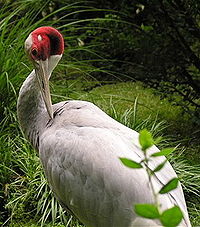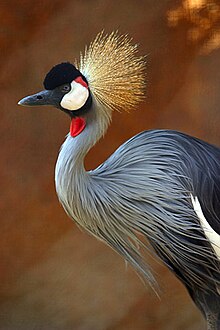This is an old revision of this page, as edited by 165.138.165.253 (talk) at 18:50, 12 March 2010 (→Taxonomy). The present address (URL) is a permanent link to this revision, which may differ significantly from the current revision.
Revision as of 18:50, 12 March 2010 by 165.138.165.253 (talk) (→Taxonomy)(diff) ← Previous revision | Latest revision (diff) | Newer revision → (diff)
| Cranes | |
|---|---|

| |
| Indian Sarus Crane Grus antigone antigone | |
| Scientific classification | |
| Kingdom: | Animalia |
| Phylum: | Chordata |
| Class: | Aves |
| Order: | Gruiformes |
| Family: | Gruidae Vigors, 1825 |
| Genera | |
Cranes are large, long-legged and long-necked birds of the order Gruiformes, and family Gruidae. There are fifteen species. Unlike the similar-looking but unrelated herons, cranes fly with necks outstretched, not pulled back. Cranes live on all continents except Antarctica and South America.
Most species of cranes are at least threatened, if not critically endangered, within their range. The plight of the Whooping Cranes of North America inspired some of the first US legislation to protect endangered species.
Biology
They are opportunistic feeders that change their diet according to the season and their own nutrient requirements. They eat a range of items from suitably sized small rodents, fish, amphibians, and insects, to grain, berries, and plants.
Most have elaborate and noisy courting displays or "dances". While folklore often states that cranes mate for life, recent scientific research indicates that these birds do change mates over the course of their lifetimes (Hayes 2005), which may last several decades. Cranes construct platform nests in shallow water, and typically lay two eggs at a time. Both parents help to rear the young, which remain with them until the next breeding season.
Some species and populations of cranes migrate over long distances; others do not migrate at all. Cranes are gregarious, forming large flocks where their numbers are sufficient.
Taxonomy


There are 17 living species of cranes in 4 genera:
SUBFAMILY BALEARICINAE - crowned cranes
- Genus Balearica
- Black Crowned Crane, Balearica pavonina
- Grey Crowned Crane, Balearica regulorum
SUBFAMILY GRUINAE - typical cranes
- Genus Grus
- Common Crane, Grus grus, also known as the Eurasian Crane
- Sandhill Crane, Grus canadensis
- Whooping Crane, Grus americana
- Sarus Crane, Grus antigone
- Brolga, Grus rubicunda
- Siberian Crane, Grus leucogeranus
- White-naped Crane, Grus vipio
- Hooded Crane, Grus monacha
- Black-necked Crane, Grus nigricollis
- Red-crowned Crane, Grus japonensis, also known as the Manchurian Crane
- Genus Anthropoides
- Blue Crane, Anthropoides paradisea
- Demoiselle Crane, Anthropoides virgo
- Genus Bugeranus
- Wattled Crane, Bugeranus carunculatus
The fossil record of cranes leaves much to be desired. Apparently, the subfamilies were well distinct by the Late Eocene (around 35 mya). The present genera are apparently some 20 mya old. Biogeography of known fossil and the living taxa of cranes suggests that the group is probably of (Laurasian?) Old World origin. The extant diversity at the genus level is centered on (eastern) Africa, making it all the more regrettable that no decent fossil record exists from there. On the other hand, it is peculiar that numerous fossils of Ciconiiformes are documented from there; these birds presumably shared much of their habitat with cranes back then already.
Fossil genera are tentatively assigned to the present-day subfamilies:

Gruinae
- Palaeogrus (Middle Eocene of Germany and Italy - Middle Miocene of France)
- Pliogrus (Early Pliocene of Eppelsheim, Germany)
- Camusia (Late Miocene of Menorca, Mediterranean)
- "Grus" conferta (Late Miocene/Early Pliocene of Contra Costa County, USA) - see Miller & Sibley (1942)
Sometimes considered Balearicinae
- Geranopsis (Hordwell Late Eocene - Early Oligocene of England)
- Anserpica (Late Oligocene of France)
Sometimes considered Gruidae incertae sedis
- Eobalearica (Ferghana Late? Eocene of Ferghana, Uzbekistan)
- Probalearica (Late Oligocene? - Middle Pliocene of Florida, USA, France?, Moldavia and Mongolia) - A nomen dubium?
- Aramornis (Sheep Creek Middle Miocene of Snake Creek Quarries, USA)
The supposed Grus prentici is not a true crane; it was eventually placed in the genus Paragrus (Lambrecht 1933:520).
Myth and lore



The cranes' beauty and their spectacular mating dances have made them highly symbolic birds in many cultures with records dating back to ancient times. Crane mythology is widely spread and can be found in areas such as the Aegean, South Arabia, China, Korea, Japan and in the Native American cultures of North America. In northern Hokkaidō, the women of the Ainu people performed a crane dance that was captured in 1908 in a photograph by Arnold Genthe. In Korea, a crane dance has been performed in the courtyard of the Tongdosa Temple since the Silla Dynasty (646 CE).
In Mecca, in pre-Islamic South Arabia, Allāt, Uzza, and Manah were believed to be the three chief goddesses of Mecca, they were called the "three exalted cranes" (gharaniq, an obscure word on which 'crane' is the usual gloss). See The Satanic Verses for the best-known story regarding these three goddesses.
The Greek for crane is Γερανος (Geranos), which gives us the Cranesbill, or hardy geranium. The crane was a bird of omen. In the tale of Ibycus and the cranes, a thief attacked Ibycus (a poet of the 6th century BCE) and left him for dead. Ibycus called to a flock of passing cranes, who followed the attacker to a theater and hovered over him until, stricken with guilt, he confessed to the crime.
Pliny the Elder wrote that cranes would appoint one of their number to stand guard while they slept. The sentry would hold a stone in its claw, so that if it fell asleep it would drop the stone and waken.
Aristotle describes the migration of cranes in The History of Animals, adding an account of their fights with Pygmies as they wintered near the source of the Nile. He describes as untruthful an account that the crane carries a touchstone inside it that can be used to test for gold when vomited up. (This second story is not altogether implausible, as cranes might ingest appropriate gizzard stones in one locality and regurgitate them in a region where such stone is otherwise scarce)
See also
References
- Archibald, George W. (1991). Forshaw, Joseph (ed.). Encyclopaedia of Animals: Birds. London: Merehurst Press. pp. 95–96. ISBN 1-85391-186-0.
- Hayes, M.A. (2005): Divorce and extra-pair paternity as alternative mating strategies in monogamous sandhill cranes. MS thesis, University of South Dakota, Vermilion, S.D.. 86 p. PDF fulltext at the International Crane Foundation's Library
- Lambrecht, Kálmán (1933): Handbuch der Palaeornithologie. Gebrüder Bornträger, Berlin.
- Miller, Alden H. & Sibley, Charles G. (1942): A New Species of Crane from the Pliocene of California. Condor 44: 126-127. PDF fulltext
External links
- Saving Cranes website (ICF)
- Craneworld website
- Gruidae videos on the Internet Bird Collection
- Origami crane
- Crane sounds on xeno-canto.org
- Cranes of the World, by Paul Johnsgard
Myth and lore links
- Crane Dance at the Tongdosa Temple (archive link, was dead)
- Thousand Cranes lore